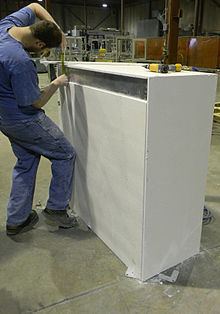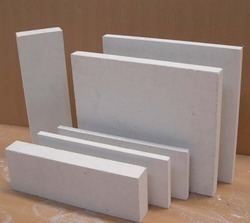Appearance White crystals | ||
 | ||
Calcium silicate
Calcium silicate (often referred to by its shortened trade name Cal-Sil or Calsil) is the chemical compound Ca2SiO4, also known as calcium orthosilicate and sometimes formulated 2CaO.SiO2. It is one of a group of compounds obtained by reacting calcium oxide and silica in various ratios e.g. 3CaO•SiO2, Ca3SiO5; 2CaO•SiO2, Ca2SiO4; 3CaO•2SiO2, Ca3Si2O7 and CaO•SiO2, CaSiO3. Calcium silicate is a white free-flowing powder derived from limestone and diatomaceous earth. It has a low bulk density and high physical water absorption. It is used in roads, insulation, bricks, roof tiles, table salt and occurs in cements, where it is known as belite (or in cement chemist notation C2S).
Contents
- Calcium silicate
- High temperature insulation
- Passive fire protection
- Acid mine drainage remediation
- As a product of sealants
- References

It is used as an anti-caking agent in food preparation and an antacid. It is approved by the United Nations' FAO and WHO bodies as a safe food additive in a large variety of products.

Calcium silicate
High temperature insulation

Calcium silicate is commonly used as a safe alternative to asbestos for high temperature insulation materials. Industrial grade piping and equipment insulation is often fabricated from calcium silicate. Its fabrication is a routine part of the curriculum for insulation apprentices. Calcium silicate competes in these realms against rockwool as well as proprietary insulation solids, such as perlite mixture and vermiculite bonded with sodium silicate. Although it is popularly considered an asbestos substitute, early uses of calcium silicate for insulation still made use of asbestos fibers.
Passive fire protection
One of the most successful materials in fireproofing in Europe is calcium silicate. Where North Americans use spray fireproofing plasters, Europeans are more likely to use cladding made of calcium silicate. High performance calcium silicate boards retain their excellent dimensional stability even in damp and humid conditions and can be installed at an early stage in the construction program, before wet trades are completed and the building is weather-tight. For sub-standard products, silicone treated sheets are available to fabricators to mitigate potential harm from high humidity or general presence of water. Fabricators and installers of calcium silicate in passive fire protection often also install firestops.

While the best possible Reaction to Fire Classifications are A1 (construction applications) and A1Fl (flooring applications) respectively, both of which mean "non-combustible" according to EN 13501-1: 2007, as classified by a notified laboratory in Europe, some calcium silicate boards only come with Fire Classification of A2 (limited combustibility) or even lower classifications (or no classification), if they are tested at all.
Acid mine drainage remediation
Calcium silicate, also known as slag, is produced when molten iron is made from iron ore, silicon dioxide and calcium carbonate in a blast furnace. When this material is processed into a highly refined, re-purposed calcium silicate aggregate, it is used in the remediation of acid mine drainage (AMD) on active and passive mine sites. Calcium silicate neutralizes active acidity in AMD systems by removing free hydrogen ions from the bulk solution, thereby increasing pH. As its silicate anion captures H+ ions (raising the pH), it forms monosilicic acid (H4SiO4), a neutral solute. Monosilicic acid remains in the bulk solution to play other important roles in correcting the adverse effects of acidic conditions. As opposed to limestone (a popular remediation material), calcium silicate effectively precipitates heavy metals and does not armor over, prolonging its effectiveness in AMD systems.
As a product of sealants
When sodium silicate is applied as a sealant to cured concrete or the shells of fresh eggs, it chemically reacts with calcium hydroxide or carbonate to form calcium silicate hydrate, sealing pores with a relatively impermeable material.
